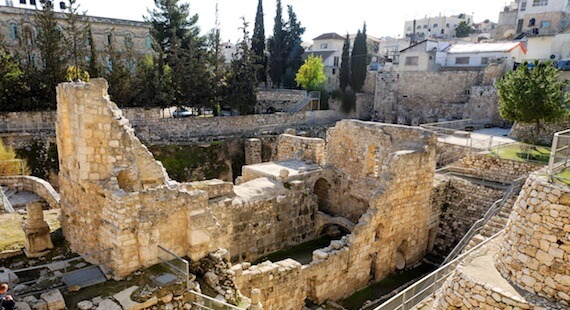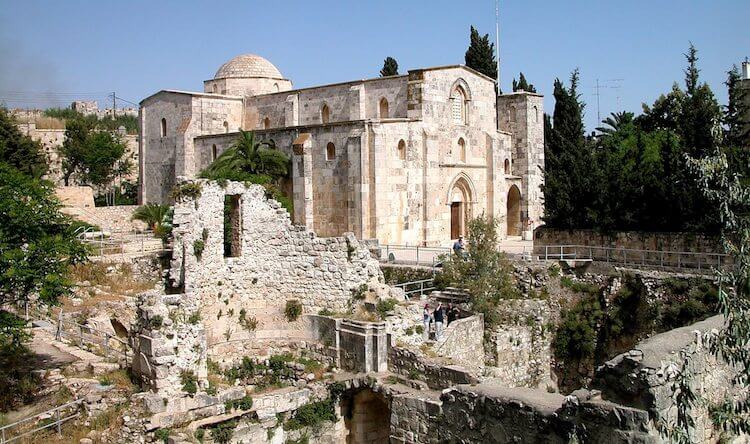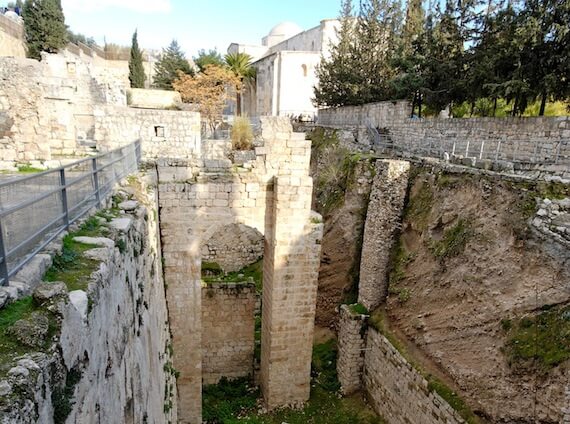Very few people are drawn to God by intimidation. Instead, the Lord urges us to come to Him by revealing the kindness of His mercy. It’s a tremendous motivation.

(Photo: Pools of Bethesda and Crusader chapel, courtesy of the Pictorial Library of Bible Lands)
Once we comprehend the depth of our imperfections, and the futility of our own efforts to remove them, we are in a position to respond to God’s kindness.
In this post, you’ll read how Jesus revealed this simple truth one day in Jerusalem with an act of mercy at the Pools of Bethesda.
Just inside Stephen’s Gate in Jerusalem lie several sites Christian visitors seldom miss.
- The Antonia Fortress served as the bunkhouse for Romans troops, and its steps leading up down onto the Temple Mount allowed the Romans to quickly quell any riots. The Apostle Paul gave a speech on the steps after one such riot (Acts 21:37-22:34).
- The other sites nearby—Via Dolorosa, the Ecce Homo arch, and the Monastery of the Flagellation—find their connection to Jesus by way of later traditions—not by history.
But enter the unassuming doorway on the north side of the street, just beyond Stephen’s Gate, and history merges with Scripture.

(Photo: Pools of Bethesda sit beside St Anne’s Church. Courtesy of the Pictorial Library of Bible Lands)
The Pools of Bethesda
A picturesque courtyard with flowers and foliage leads to deep pits with ancient, stone walls. These are the Pools of Bethesda.
- Even before the time of Jesus, this location may represent a shallow valley dammed to retain rainwater and referred to as “the upper pool” in the 8th-century BC (2 Kings 18:17; Isaiah 7:3).
- In the first century, the site had two adjacent pools with a surrounding colonnade on all four sides and one down the middle. The Book of John refers to “a pool, which is called in Hebrew Bethesda, having five porticoes” (John 5:2).
- The Bible reveals that Jesus had mercy on one of the many invalids who lay by the pools—and healed him (John 5:9).
- Under the Emperor Hadrian in the second century, Jerusalem became the pagan Aelia Capitolina, and the site of the Pools of Bethesda expanded to include a pagan temple with offerings to the Greek god, Asclepius.
Saint Anne’s Church
The Byzantines in the fifth century constructed a church to commemorate Jesus’ miracle at the pools.
- When the Crusaders rolled in to Jerusalem many centuries later, a church still stood on the site—though how it escaped Fatimid sultan Hakim’s demolition in 1009 remains a mystery.
- The church that stands today, Saint Anne’s Church, is one of the most beautiful in Jerusalem and reveals Crusader Jerusalem’s finest architecture. Built in 1138, the Romanesque church allegedly enshrines the home place of the Virgin Mary’s parents, Joachim and Anne. The Crusaders also built a chapel by the pools. Its crumbling ruins still stand.
- In 1192, after the Muslims overtook Jerusalem, Saladin used Saint Anne’s Church as a theological school, placing an inscription above the door that still remains to this day.
- Over the centuries, the church eventually fell into significant disrepair. Only after the French received it as a gift from the Turks in 1856 did it get restored to the lovely sanctuary we see today.

(Photo: Pools of Bethesda and Saint Anne’s Church in background, courtesy of the Pictorial Library of Bible Lands)
Most well known for its amazing acoustics, Saint Anne’s Church enjoys the voices of thousands of Christian tourists each year singing praises to God.
Hope from the Pools of Bethesda
Modern versions of the Bible indicate that John 5:3b-4 are missing from the earliest and best manuscripts. Likely John didn’t write these verses, but someone inserted them after AD 400 to explain the superstition the sick man mentioned in John 5:7.
- A mystical notion existed that an angel of God would stir the waters at the Pools of Bethesda, and the first person to enter would get healed.
- Not only do the early manuscripts offer no support for these insertions, but good theology also contradicts this cruel, works-based arrangement.
When Jesus asked sick man, “Do you want to be healed?” his answer revealed that he believed that healing depended on his ability to outrun the others to the Pools of Bethesda.
- He clearly believed the superstition, and thus, he saw his prospect for healing as hopeless.
- Jesus’ healing of this man revealed that God’s kindness is available not simply to the swift—but to everyone.
When the Lord later searched for him and “found him in the temple” (John 5:14), Jesus’ words show that the physical healing represented an act of God’s kindness intended as an incentive for the healed man to repent of his sins.
Think about how God’s kindness has proven abundant in your own life. Indeed, God’s kindness toward us is a huge motivation to urge us to repent and to obey Him.
Do you think lightly of the riches of His kindness and tolerance and patience, not knowing that the kindness of God leads you to repentance? —Romans 2:4
Tell me what you think: How has God’s kindness toward you urged you to change? To leave a comment, just click here.
